Treblinka: 80 Years Since the Daring Uprising and the Liquidation of the Camp, Av 1, 5703/August 2, 1943
Contents:
A) On the Way to Treblinka – Ani Maamim (I Believe)
B) “He Murdered and also Inherited” – The German Precision Reflected in the Looting of Victims’ Property and Belongings, until the Very Last One
C) The “Synagogue”
D) “In a Fit of Rage” – A Description of the Uprising by the Survivors
On the Way to Treblinka – Ani Maamin (I Believe)
The voice of Azriel David Fastag was the talk of the whole of Warsaw. Many flocked to the synagogue where Azriel David and his brothers, also singers, used to pray during the High Holidays. Azriel David would pass in front of the ark and they accompanied him as a choir. He was gifted with a loud, clear, and emotional voice, which carried away all his listeners. His material life was quite modest, but he got most of his satisfaction and happiness from another source – from the world of music. His emotional melodies made their way straight to Otwock, to the study hall of his rabbi, Rabbi Shaul Yedidya Elazar of Modzitz, a composer in his own right, who liked Azriel David’s tunes very much. The chassidim around the Rebbe already knew that on days when a new tune of Azriel David arrived to his court, it was a holiday for the Rebbe.
The skies of Europe darkened with black clouds, the clouds of the Nazi occupation. Despite the discrimination laws, the yellow patch, and the ghettos, most European Jews did not believe the gloomy predictions. Only a few read the map correctly and even managed to escape from the realm of the Nazi occupation and reach a safe place. One of them was the Rebbe of Modzitz, whose followers went to great lengths to save him. When the Nazis entered Poland, the Rebbe was smuggled to Vilna, and from there to the United States via Japan. Now Azriel David, with thousands of his Jewish brothers, was crammed into one of the death trains, on the way from Warsaw to the Treblinka extermination camp. The air in the packed cattle car was stifling. Men, women and children, who drank only air and water, were brutally crushed by the Nazi animals. Previously, couples were separated from each other, children were torn from the hands of their parents, and failing elders were shot to death in front of their loved ones. The train set off. Azriel David was introspective. The monotonous rattle of the wheels, with the little air that seeped in through the small window, calmed down the atmosphere somewhat. The people stood glued to each other, moaning and groaning quietly. In front of Azriel David’s eyes suddenly the words of the 12th principle of the Rambam (Maimonides) arose: “Ani Maamim be’emuna shelaima be’viat hamashiach, v’af al pi she’yitmahame’ah, im kol zeh achakeh lo bechol yom she’yavo” (I believe with complete faith in the coming of the Messiah, and even if he delays, with all this I will await him every day). He closed his eyes and delved into the words and his plan. Precisely now, he said in his heart, when everything was seemingly lost, a Jew’s faith is tested.
And suddenly his lips began to murmur in a quiet plea. The pleasure poured into her, and slowly it connected to the words until they were united. Azriel David’s devotion grew and faded from moment to moment. His eyes were closed and his body was cramped, but his spirit detached itself from the circumstances of time and place and soars upwards. He did not at all feel the absolute silence that prevailed in the train and the hundreds of ears amazed to hear the wonderful sounds, as if they were taken from a completely different world. He didn’t either hear the voices that joined later in his singing, at first quietly, and moment by moment louder and louder with the holy words, combined with the pure faith in the hearts that broke out in great and mighty poetry. A whole cattle car, crammed with humiliated, starving, and oppressed people, making their way to Treblinka, sang loudly: “I believe…in the coming of the Messiah…and even if he delays.”
This wonderous singing continued for a long time. Suddenly, as if waking from a distant dream, Azriel David opened his eyes and looked at them. His eyes were red from crying and his cheeks were wet from tears. He was very upset.
“Dear brothers!”, he addressed those around him, “this melody is the melody of the Jewish soul. This is the melody of pure faith, which even thousands of years of exile and persecution could not break.” His voice choked for a moment. “I would like to offer everyone an unusual deal: whoever jumps off the train, will save himself and will be able to bring this melody to my teacher and the Rebbe of Modzitz, I grant him half of my portion of the World to Come…”
Azriel David stood up on his tiptoes and surveyed the heads of the people. A moment later 2 hands were raised. These were two young men who still had strength. “Accept me,” one said. “I am ready for the deal,” said the other. A little while later, the two succeeded with the help of the others to dismantle the boards that closed off the small window at the top of the car. They broke away from their brethren and jumped one after the other from the speeding train.
After some time, one of the two showed up at the door of the Modzitzer Rebbe in the United States.
It turned out that his friend was crushed to death upon jumping from the train, but he himself was saved and managed to escape from hell. He entered the Rebbe’s room, gave over the entire story to the Rebbe, and sang the song of Azriel-David, one of the Rebbe’s followers. The entire time, the Rebbe sat in front of him and wept bitterly. It was the Modzitzer Rebbe who spread Azriel David Fastag’s music all over the world. “With this melody, Jews marched to the gas incinerators,” he said, “and with this melody, Jews will march to receive the Messiah.”
Source: Sichat HaShavua, Tzeirei Agudath Chabad
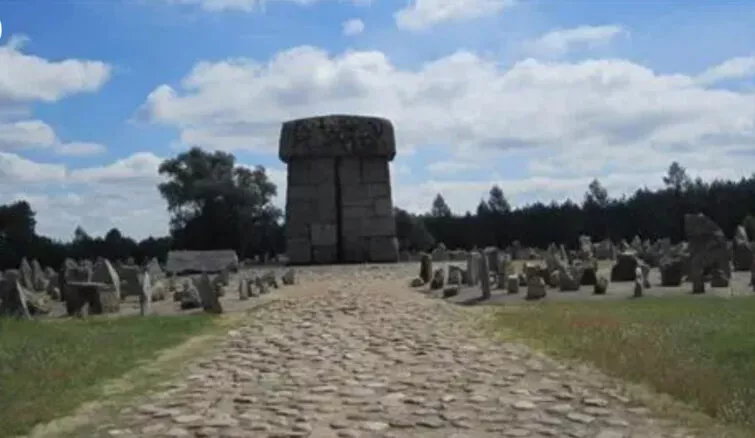
Treblinka today
“Ani Maamin” (I Believe) – Song by Rabbi Aharon Levi
Look around how everything is so green
And the forest is silent in shame.
Stones are scattered here like candles for souls
It’s Treblinka, a whisper rises.
Like a field plowed after the harvest,
As if it never grew.
And from the silence here stones sing
What happened on the way here?
Chorus: Ani maamin…ani maamin…ani maamin…
In a cattle car amongst thousands of people
And the skies black above
He began to hum
And sang the tune in a whisper
And in silence they looked at him
And the tears flow
And crying angels
And letters flourish in the air,
When “I believe” from dry throats
Erupts like a mighty thunder.
Chorus: Ani maamin…
And a small child asks his father
If it can be before –
When we really get there, he will come.
Or maybe it will happen – –
after…
And the father cries:
Son, it does not matter
And here is the wood and fire
And if we do not meet
So continue to ask
A Jew is persistent till the end!
Chorus: Ani maamin…ani maamin…ani maamin…
And everyone is silent here
And the world was silent
And the tops of the trees are still.
Do not touch the Messiah, stones cry out
Shine till today like candles.
And you will see when he comes and builds
And his universe is sown with tears.
And the stones will live and sing with him
Both with words and with a melody.
Chorus: Ani maamin…
Until No Trace Remains – The Treblinka Extermination Camp
By: Author and researcher, Mr. Itamar Levin, Globes 8.4.2022
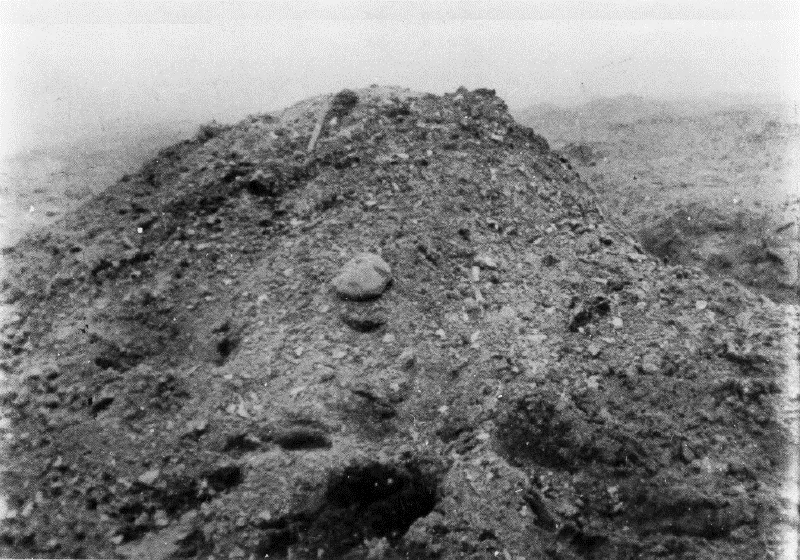
A pile of ashes in Treblinka
A dirt road leads through the forest trees. The only sounds are the chirping of the birds, the footsteps, and the voices of the visitors. If it weren’t for the clearing, which is reached after a few minutes of walking from the parking lot, there would be nothing to distinguish this patch of forest from tens of thousands of other dunams of forests that adorn Poland.
However, in the forest clearing there is a memorial, surrounded by hundreds of stones that together create a cemetery-like scene. Here was the death factory known as Treblinka. It is almost hard to believe that this small area between the trees – 600 meters long and 400 meters wide, whose perimeter can be walked around in less than half an hour – is the place where 870 thousand people were murdered. All, with the exception of 2,000 Gypsies, were Jews.
The journey from Warsaw to Treblinka currently takes an hour and a half; the victims tottered here for hours, sometimes days, without food, water, or air to breathe. Many of them arrived lifeless. Today, only a few visitors come here. The fact that the camp was completely destroyed and became only a memorial site probably detracts from the interest it arouses.
The world, which needs specific symbols to understand large-scale and significant events, chose Auschwitz as the landmark of the Nazi atrocities in general, and of the extermination of European Jewry in particular. Many other sites, including Treblinka, were relegated from the popular collective memory.
And perhaps there is also a virtue in this: while Auschwitz is crowded with visitors all year round, it is precisely the silence of Treblinka that evokes a sense of anguish. It’s almost hard to believe that birds were chirping, the trees grew, and the flowers bloomed even then, more than fifty years ago – when hundreds of thousands of people, sometimes not much more than walking skeletons, were crammed into the gas chambers on their last journey.
“The camp square was flooded with candies”
Treblinka was one of the three camps where Polish Jews were exterminated as part of “Operation Reinhard”, along with Belzec and Sobibor. The camp was established in 1941-1942 northeast of Warsaw, 4 km from the tiny village that still bears the same horrible name.
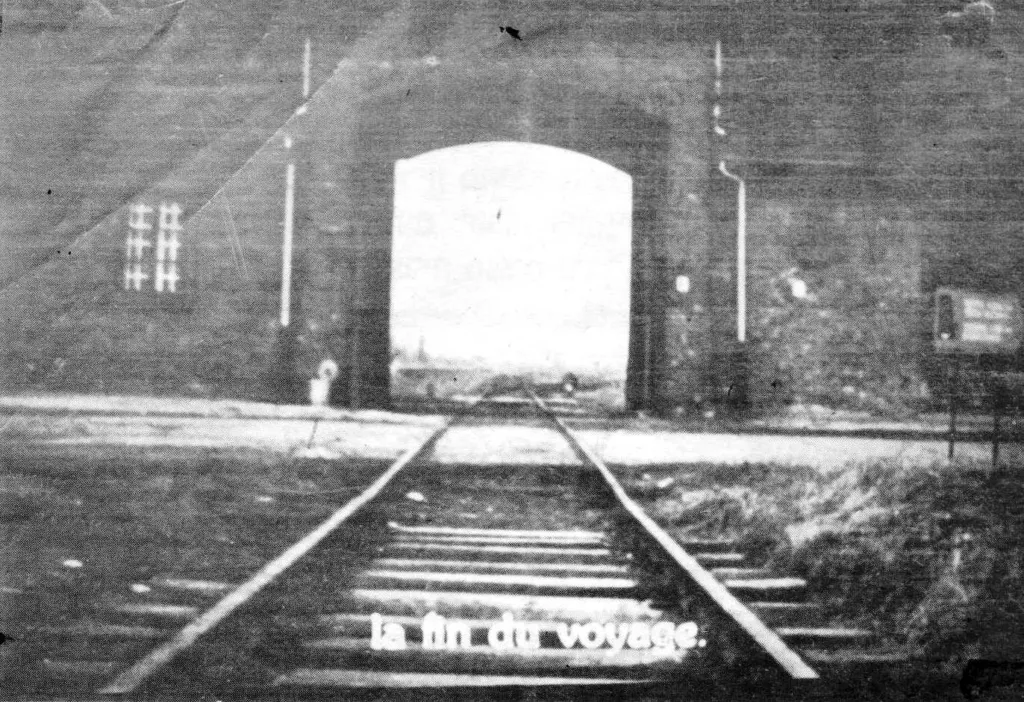
The entrance to Treblinka
When the first of the deportees from Warsaw arrived at Treblinka, they were greeted by a sign with a message in Polish and German: “Jews of Warsaw, please note! You are in a transit camp from where you will be sent to a labour camp. To protect yourself from plagues, you must immediately hand over your clothes and belongings to be disinfected. Gold, silver, foreign currency, and jewelry must be handed over to the cash register in exchange for a receipt. These things will be returned to you later in exchange for the receipt. In order to keep the body clean, everyone who comes must bathe before continuing the journey”. The showers were, as you know, gas chambers.
Yaakov Wiernik, who arrived in Treblinka on August 23, 1942, immediately saw that “the area was flooded with packages, suitcases, clothes, satchels, everything that the victims took off before their horrible death… The square was strewn with piles of various objects. It goes without saying that millions of people (an exaggerated number) leave behind millions of clothes, bedding, etc. And yet, each one believed that he was going to be sent onwards, but not to death, and therefore took with them all their good and necessary things. The satchels, suitcases, and sacks were full. The food was excellent.
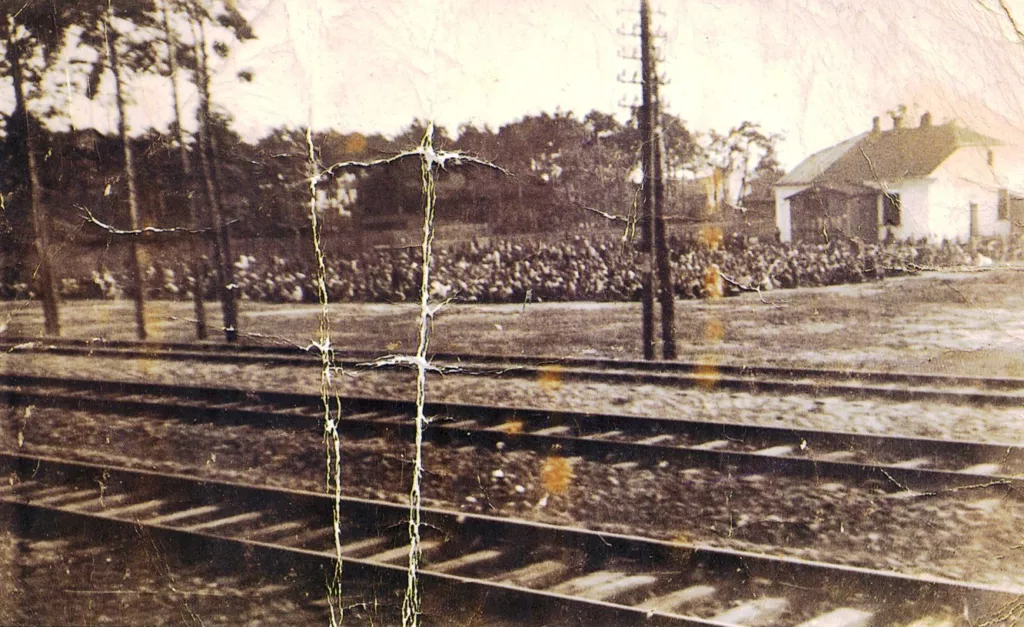
The Jews of Otwock wait for 3 days at the station on the way to Treblinka
“In the square of Treblinka you will find everything your heart desires. Everything in large quantities. Once upon a time I oversaw a large pile of fountain pens, real coffee, etc. The camp square was flooded with candies. The deportations from abroad (i.e. outside Poland) brought with them a lot of fat. These people believed wholeheartedly that they would stay alive.”
“Women’s hair was used to make socks”
From the beginning of September 1942, 500-600 Jews were employed in the camp. Some of them were involved in removing the bodies of those who died on the way and burying them, others helped to deal with the deportees on their way to the gas chambers, and another group cleaned the gas chambers after the murder. There were prisoners who were tasked with transporting the bodies of the victims for burial, and others were engaged in the actual burial. In addition to all of these, there were groups entrusted with the victims’ property, and they are described by Dr. Yitzhak Arad in his very important study on “Operation Reinhard”:
*The Gold Jews: A group of about 20 prisoners, most of them goldsmiths, watchmakers, and bank workers by profession. Their job was to receive and sort the money bills, gold, and silver items, certificates, and other valuable items taken from the victims on their way to the “showers”.
This group was also assigned to search the bodies of the victims, in case any objects were hidden inside them. These prisoners could secretly take some of the loot for themselves (probably to purchase some essential food), and the SS men also needed cooperation on their part, in order to “secure their share of the wealth that will roll in the camp”, as Arad put it.
*Hair cutters: About 15 prisoners, most of them professional barbers, who cut the victims’ hair before entering the gas chambers. This operation began following an order from the commander of the Economic and Administrative Main Office of the SS, Oswald Paul, who – according to the wording of the order – “ordered the use of human hair, collected in all the concentration camps. This human hair will be threaded on coils and made from it alone for industrial purposes. The hair, after it is combed and cut, will be used to make socks for submariners and felt pozmaki for railway workers.”
*Clothes and belongings sorters: A group that numbered 80-120 prisoners, which was divided into sub-groups. These prisoners worked in the sorting yard, where the victims’ belongings were piled up, and in the warehouses to which these belongings were transferred. They were tasked with gathering the clothes and belongings, sorting them into their types, tying them in bundles of 10 or 25 units, preparing them for shipment, and finally loading them onto the train cars headed west. Among other things, they had to take out of the clothes and belongings all the valuables, money, certificates, and photos, and remove the yellow patch from the clothes.
*The “dentists”: 20-30 prisoners, who were assigned to remove the gold teeth, platinum teeth, and dentures from the mouths of the corpses after they were removed from the gas chambers, and to search again for valuables hidden on the victims. Some of them were employed in cleaning and sorting the removed teeth, and preparing them for shipment to Germany.
“Different objects are piled on the blankets”
As we have already seen, there was a sign at the entrance of the camp announcing that it was a transit camp to be used on the way to a labour camp, and that the deportees must undress in the reception hut, hand over their belongings to a deposit station, and shower. First, the workers of the sorting group moved the clothes and belongings to the sorting yard, where mountains of clothing, shoes, and different types of posessions were piled up. When the rate of extermination increased, the victims themselves were ordered to take their clothes and belongings, run naked – even in the cold and snowy days – to the field, and lay them in the appropriate piles.
Kalman Teigman was among the prisoners whose job it was to sort the property of the murdered. Immediately after arriving at Treblinka, Teigman and 200 other prisoners were separated from the rest of the deportees and ordered to stand aside, while the others undressed and were taken to the gas chambers. After that, Teigman and his friends were brought into the empty barracks, where they found – as he put it – piles of clothes, shoes, toys, and glasses. Their job was to grab piles of objects, and run with them to the yard.
Then, Teigman continued in his testimony at “Yad Vashem”: The prisoners had to “first of all, check that there was nothing inside. We found a lot of things there – gold, jewelry, money. People sewed inside the clothes and we had to remove the names sewed onto the clothing, signs, and sort all these things, this means: groups of pants separately, fabrics separately, and shirts separately, make big piles and tie them inside sheets, bundles like that. Towards evening or in the afternoon, a big train came again, and we had to load the things onto these train cards.”
Oskar Strebaczinski, a Jewish prisoner who was employed in sorting work, said: “The group to which I belonged, which consisted of hundreds of people, arrives at the field and began work… On the blankets and tablecloths spread out on the ground, various objects are piled up, from foreign fabrics and very expensive suits to mere rags… From the suitcases we take out haberdashery, cosmetics, soap, matches, medicines.”
“It seems that there is no object in the world that is not found here in large quantities, of all kinds, from the most expensive preserves to a few potatoes that poor Jews brought with them. The sorted objects are routinely transported to the edge of the lot, where they are piled up, level by level. A special place is occupied by the suitcases for valuables in which gold items, watches, rings, diamonds are placed. The main valuables are wedding rings. There are also large quantities of foreign currency, dollars in notes and coins, pounds sterling, and Russian gold coins. Polish money was collected here in large piles.”
“From time to time, prisoners from the ‘Gold Jews’ come to the lot, and take suitcases full of valuables and money with them to their place of work, and leave the empty suitcases they brought with them in their place. They also fill up in a short time… the whole lot gives the impression of a market, the kitchen utensils and bottles have a special place. Among the kitchen utensils there are nickel or aluminum utensils – from the most expensive ones to broken and old pots.”
“Separate between dentures and natural teeth”
The agony of the hundreds of thousands of victims did not end even after they were suffocated in the gas chambers. On their bodies way to their final rest, the Nazis sought to extract from them every possible profit. This is where the “dentists” came into the picture, who were ordered to remove the prosthetic teeth, even if this meant removing the entire jaw. Yechiel Reichman said at the Demjanjuk trial:
“Every time a transport of people arrived, who a few minutes later would be dead, they called us. We would go downstairs. There were many bowls, one on top of the other, and we were arranged in groups of six people on each road (leading from the gas chambers to the burial pits). If there was more than one road, more than one lane, they took six times two or times three.”
“And so the work was. The first one was standing. In front of him was a bowl with some water, and he had to check the stretcher bearers, whether the corpse had false teeth… If so, he would take it (the stretcher bearer with the body on it) out of the line of runners and remove his teeth, so that he wouldn’t delay the others, and so did the other one… each of the six. It turned out that all six together had to check all the corpses that the stretcher bearers passed by with.”
“The stretcher bearers ran with the dead, and they were interested in getting rid of the tooth extraction as quickly as possible, because they were not allowed to lay the dead on the ground, but had to hold the stretcher all the time… and there were cases where we dentists were beaten for letting them pass a corpse with its dentures on. I once even received 25 lashes.”
“…When there were no transports, we were in our workshop (a room in the barracks that was adjacent to the gas chambers) and there was work. We had to separate these artificial teeth from natural teeth, and sometimes inside the crowns of the teeth were hidden valuable things like diamonds. In addition, we had to clean the gold teeth well, so that they would be clean, and every week we would deliver a suitcase with gold, which we estimated at about 10 kg of gold every week.”
“Among the “gold Jews” was Avraham Lindwasser, a man from Warsaw, whose story at the Eichmann trial was particularly shocking. An SS man led him to a well next to the gas chambers. ‘Next to the well stood two bowls with gold teeth, and also tongs for removing teeth. He ordered me to take tongs, and by the cabins (the gas chambers) to remove teeth from the corpses.'”
Lindwasser fulfilled this terrible task for about a month and a half, “until I suddenly recognized my dead sister.” So he asked the group’s commander, Dr. Zimmerman, to move him to work inside the barracks of the “gold Jews”, where the prisoners were busy separating the fillings (both gold and porcelain) from the teeth. Lindwasser estimated that every week two suitcases containing 8-10 kg of gold teeth left Treblinka. He also said that the gold, money, and valuables were sent from the camp in an armored car or a special train car, accompanied by a watch of German SS men and members of the Ukrainian auxiliary forces.
The Germans did not underestimate any object. Alexander Kudlik said that he was employed for six months, 10 hours a day, sorting fountain pens made of gold. Shmuel Reisman was employed for three months sorting glasses. He also tells about an order that came one day to remove the artificial and worthless stones from the women’s brooches, and to send only the metal to Germany.
Reisman was a member of a secret committee of prisoners whose goal was to document what was happening in Treblinka. According to their lists, 15 trains cars loaded with women’s hair, 248 train cars of suits, about 100 train cars loaded with shoes, over 40 train cars including medical equipment and medicines, 12 train cars including small craft tools, 260 train cars loaded with bedding, hundreds of train cars of various clothing items, and another 400 train cars containing various items such as tableware, baby carriages, women’s purses, suitcases, umbrellas, fountain pens, glasses, razors, and much more were sent from Treblinka. In total, he says, 1,500 train cars loaded with objects were taken out of Treblinka.
The Pole Franciszek Zavetski, who worked at the Treblinka train station, concluded that over 1,000 wagons filled with the victims’ belongings passed through the station during the time the camp was in operation. Arad points out that this estimate is close to the data appearing in the documents of the general management of the railway in the eastern regions, according to which three trains with 153 cars loaded with clothes left Treblinka between September 9 and 21, 1942. Arad assumes that the clothes took up a third of the volume of looted property, and therefore should have left Treblinka during this period – when a third of all the camp’s victims were murdered – 450-400 cars Loaded with stolen property. Hence, the property of all the murdered took up 1,350-1,200 cars.
Decorative coverings to rags
In January 1944, the commander of “Operation Reinhard”, Odilo Globocznik, sent a summary report to the SS commander, Heinrich Himmler, about the property looted during the operation in the three camps. There were 2.9 tons of gold bullion worth 8.41 million Reichsmarks; 18.7 tons of silver worth 749 thousand Reichsmarks; and 15 kg of platinum worth 77 thousand Reichsmarks. In cash, more than one million American dollars (2.7 million Reichsmarks), 2.45 million Soviet Rubles (245 thousand Reichsmarks) and 119 thousand Swiss Francs (692 thousand Reichsmarks) were robbed.
Among the jewelry and other objects stand out 15,883 inlaid gold rings, 13,458.62 carats of diamonds, 2,947 gold brooches, 114.20 kg of pearls, 3,240 silver wallets, 1,315 briefcases, 2,343 alarm clocks, 6,943 alarm clocks in need of repair, 29,391 pairs of glasses, 60,125 watches of various types (probably in good condition) and 103,614 ordinary watches that must be sent for repair. In the textile sector, it was 1,901 freight cars loaded with clothes, underwear, bedding, and rags. Finally, the summary came:
*Money in Polish zlotys and Reichsmarks – 73,852,080.74 Reichsmarks.
*Precious metals – 8,973,651.60 Reichsmarks.
*Foreign currency in bills – 4,521,224.13 Reichsmarks.
*Foreign currency in gold – 1,736,554.12 Reichsmarks.
*Jewelry and other valuables – 43,662,450.00 Reichsmarks.
*Textiles – 46,000,000.00 Reichsmarks.
*Total: 178,745,960.59 Reichsmarks, which were then 71.5 million dollars – about 750 million dollars in modern terms.
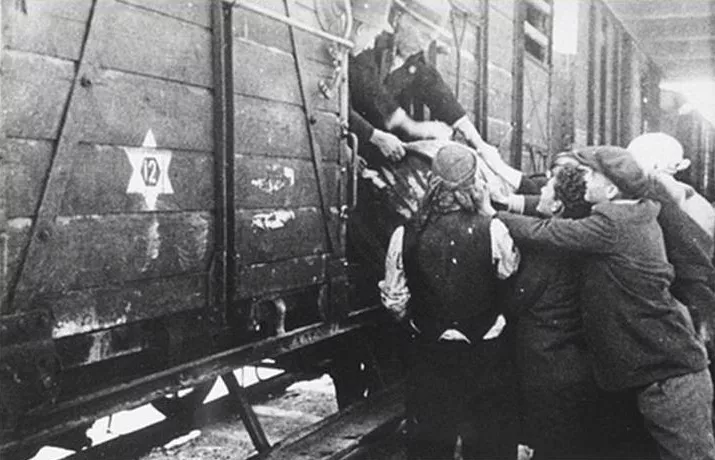
Yugoslavian Jews load a barrel of water onto the train that will take them to Treblinka
Shema Yisrael (Hear Oh Israel)
“When we closed the door and spread out like sand, the process of gas injection began…
Let me just explain what I heard before I opened the gas chambers. It’s horrible. When the victims were inside, the first ones did not know where they were entering, did not know what awaited them inside.
But it’s already filled from the other side of the cell I began to hear terrible cries, terrible shouts, ‘Mama, Tata’ – mother father.
Children’s names.
It was dark inside. One could not see anything…
The screams were terrible, the crying was terrible. Mama, Tata… Shema Yisrael, and so on.
It happened.
I listened for fifteen minutes… after twenty minutes everything went silent and I started hearing moans of people, and then slowly everything went silent.”
Source: Ani Maamin, M. Eliav
The “Lazarett” (Field Hospital)
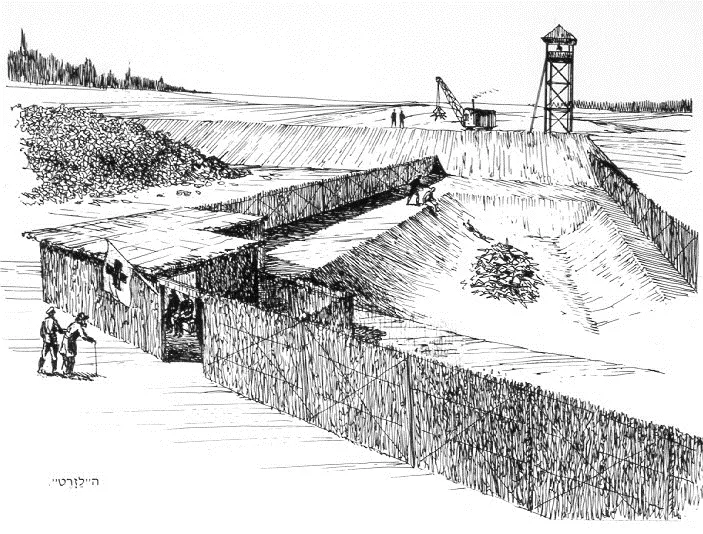
Drawing of the “hospital”, to which the sick and elderly were directed to en masse, straight to their death, by shooting them into a pit
“The lazarett there had an entrance and before that there was a pit. This pit was covered (from view) by the fence. If I explain myself well. Surrounded by the fence. There was an entrance, a flag with a red cross was flying above and outside stood a Jew…with a leather jacket and boots with a casket and a Red Cross ribbon.
It’s like coming to the hospital. ‘Lazarett’ is a kind of hospital in German… a clinic if I’m not mistaken… and there they would go into a room, if we call it that, I don’t have a word to use.
There was a table and what looked like a chair. Another Jew was sitting there, as if he was taking notes, not remembering what…
From this room, once again, it’s not a room, it’s a corner, it was also fenced off with the same branches so that they wouldn’t see. From the side they were taken out to the edge of the pit, and at the edge of the pit there were SS men standing there.
The ‘Americanero’. That’s what I called him, and another Ukrainian shot these unfortunates, and they rolled directly onto the fire, into this pit. At first I think… there was garbage there and the garbage was burning… it was the dump, and this dump was burning day and night… and there the victims fell after being shot at, on the dump”…
-Testimony of Charnie, Protocols of the Demjanjuk Trail
Synagogue in Treblinka – Testimony of L. Feingold
From the hundreds of thousands of Jews from all European countries, occupied by the Nazis, who were brought toTreblinka, where they were suffocated and burned, three hundred Jews have so far been allowed to remain alive. Indeed, these were saved, but their lives near the suffocation houses are weighted against any strange death. It is the healthy and strong young men, tasked with living until they lose their strength.
They also have no escape from this hell, the wire fence is electrified. They have no other way out, except to work on the orders of the SS. In the burning of the bodies, in lime and gasoline, and in organizing the posessions of the suffocated.
Every day early in the morning, the three hundred young men are taken out of the holes that have been given the name “barracks”, and this is how they work when the fools of the SS men. They whip their backs until they bleed, until dark.
The rain penetrates the “barracks” through the broken roof, washing the wounds. The eyes see through the veil of darkness all the dead bodies, which were alive a short time ago. In my ears rings the horrifying cry of the mother who managed to ask for her son, one of the “luckiest” among the three hundred: “Menachem my only son, remember to say Kaddish for your mother, as long as you live…” and Menachem’s answer is heard here with terrible clarity. Here he is doing his work with his friends, while his lips are constantly dubbing: “Exhalted and hallowed be His great Name!…”
The sun sets. Treblinka trees cast a dark shadow that falls on the white wooden huts and shine in the last rays of light. The work had just ended, and the boys, bloodied, broken and torn, thirsty and hungry, were returned to their barracks. There is no strength to let out a sigh, the heads are lowered – as if they are ashamed to look at each other. Menachem suddenly jumps out of bed, covers his head with his hands and announces: “Jews! I think that it is the holy Shabbat today, indeed the holy Shabbat is today!” Everyone is silent, frozen, as if they do not have the strength to say and hear that today is Shabbat, but Menachem opens:
“A Psalm, a song for the Shabbat…”
In the blink of an eye, everyone rises from their beds, they too begin by saying “a psalm, a song for the Sabbath day.” But Menachem suddenly stops, as if remembering something. He takes out from under his jacket two small candles and a match, places them on the floor and lights them. Menachem fixes his gaze on the pair of flames. Everyone stands around the candles, covering their heads with their hands and hiding the candles with their bodies, so that their light does not shine out. Menachem enthusiastically declares:
Friends it is Shabbat! Let us accept the Sabbath!
And here a comforting man turns his face towards the east and opens with a mournful voice, as the boys say after him: “Come, my friend, to meet the bride, let us welcome the Sabbath…Get up from your ruins, long enough have you dwelt in the valley of tears!”
The worshipers invest themselves in prayer. All that they carried in their broken hearts in the days of terror, when thousands of their brothers were murdered and tortured before their eyes, all the sorrow and anger that had accumulated over weeks, all of this found an outlet in the Kabbalat Shabbat prayer of those condemned to death. The place where they prayed, suddenly became sanctified and became the sole contents of their lives. At that moment the boys forgot their surroundings and remembered only the Creator of the world.
Before Him they will now lay their cry, a cry and a promise as one, to to continue to believe in His oneness, despite the impurity and evil that surrounds them. In their prayer they said Kaddish for all those millions of holy and pure people who were killed before their eyes in sanctification of G-d’s Name. Since then the barrack was turned into a synagogue.
The Daring Uprising and Its Tragic End
In August 1943 (Av 1, 5703) the inmates of the Treblinka camp, with great resourcefulness and cooperation, managed to wreak havoc in the extermination machine and escape to their freedom. The story of the heroic uprising in Treblinka is not known to many, and did not receive the same fame as the uprisings in the ghettos or in Auschwitz.
The first to try to forget and erase the matter of the rebellion were the Nazi camp commanders, who were ashamed of their failure. The old prisoners who were responsible for the operation of the camp began to notice that the shipments were dwindling. Rumours about the defeat of the Germans in Africa began to spread. However, the incinerators worked at their peak, and the extermination machine continued vigorously.
The prisoners felt that the end was near. They understood very well that the Germans would soon destroy them and the entire camp. The underground infrastructure, which was dormant, woke up to immediate action. The goal of the insurgents was the demolition of the extermination facilities in the camp and revenge on the Nazis. The organization was headed by the camp’s elder, Alfred Galewski, and it was made up mostly of the camp’s kapos.
The rebellion was organized and coordinated while compartmentalizing its participants, only a number of insiders in each unit were involved in the complete plan.
At the outbreak of the rebellion, it seems that there were about 60 area commanders out of about 1,500 prisoners who participated in the rebellion, each of whom was given a role. The target date was set for August 2, 1943. A severe fever prevailed in Treblinka that day. Galevsky dispersed the prisoners after the lunch order, and a group of four SS men and 16 Ukrainian guards left the camp to bathe in the Bug River. At the same time, Rudek Lubernicki, who was in charge of the garage, sabotaged an armored car parked near the garage and made it unusable. Then Lubernicki took out razors and wire cutters from the warehouse and distributed them to some of the members of the underground. At 14:00, prisoners entered the weapons warehouse, after taking care to distract the officer on duty, and packed rifles, pistols, hand grenades, and ammunition into sacks. The sacks were passed through the window to the garage, where the weapons were distributed to the members of the underground. At the same time, the prisoner responsible for disinfecting the camp filled the disinfectant tank with gasoline and began to spray it on the barracks, in order to set them on fire. But then the plan went wrong. SS man Kurt Kittner was seen hanging out with a Kapo who was known as a whistleblower.
When they parted, Kittner caught one of the prisoners walking around with bills in his pocket. The leaders of the underground feared that the prisoner would reveal the plan of the rebellion, so they decided to kill Kitner. A young man from Warsaw named Walbanczyk was sent to shoot Kitner, but he was not killed and managed to escape. This happened around 4:00 p.m., and the shot ignited the rebellion earlier than the appointed time.
Shots and explosions began to be heard in the camp, the barracks were set on fire and the fuel depot was also set on fire, causing a huge explosion. At this point, things got out of control. The Ukrainian guards began shooting at the prisoners, who returned fire with small arms, threw grenades, and began to escape to the southern area of the camp with the intention of breaching the fences.
At the same time, the uprising order was also given in the upper camp. The Jews attacked the Ukrainian guards with shovels and harpoons. Some members of the underground broke into the guard room, took weapons and ammunition, and returned fire at the Ukrainians. Other prisoners set fire to the barracks. When the commotion increased, the prisoners turned to the southern fence in order to break through it and escape.
The uprising put the commanders of Treblinka in a most embarrassing situation. They knew that if its existence became known, their careers would be destroyed, and therefore they did everything in their power to keep it quiet. Indeed, information about the uprising is not found in the German archives from the time, and in the report of the camp commander Franz Staengel it is claimed that by 18:00 the uprising was suppressed and all the insurgents were captured or shot.
The reality was completely the opposite. Although many of the prisoners were shot and killed during the uprising, about half of the 850 prisoners who were imprisoned in the camp that day managed to break through the fences and escape. About two hundred of the escapees were caught by the Germans, murdered by Polish peasants, or handed over to the Germans by them, but in the end about 70 of the escaped prisoners got to see the Third Reich fall. Despite the damage caused to the camp as a result of the arsons, it continued to function, albeit in a much more limited format. About a hundred prisoners remained in the camp who did not escape due to fear or weakness. Franz Staengel used them for the benefit of the camp’s restoration and operation, and thus managed to give the place an active character. Towards the end of the summer, two shipments from the Bialystok ghetto arrived in Treblinka, containing about 8,000 Jews. These were the last murdered in the camp, and then the factory was about to stop its gruesome work. In the fall of 1943, the camp was completely dismantled.
The few prisoners left in the camp when it was dismantled were shot to death and their bodies burned. The uprising in Treblinka was one of the successful uprising attempts of the Jews against the Nazis.
In the midst of the mass murder, prisoners who were held in impossible conditions managed to overcome the killers for a while and escape. This is a heroic achievement that deserves to be remembered alongside the other descriptions of heroism of those who resisted the Nazi death machine.
Source: Segula history magazine
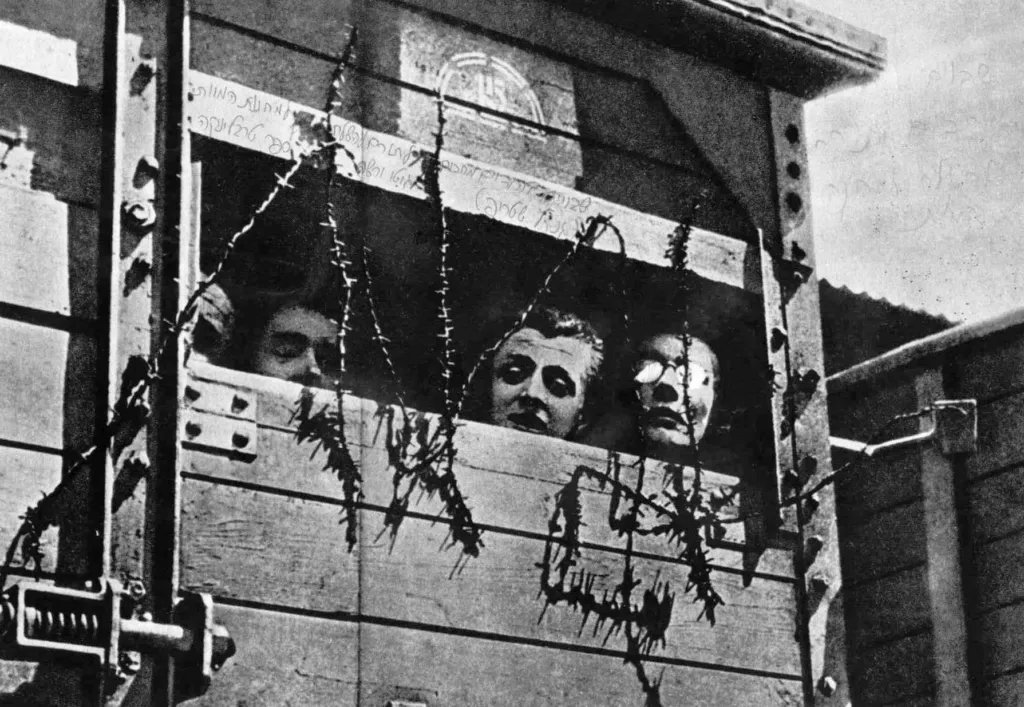
Jews on a train to Treblinka
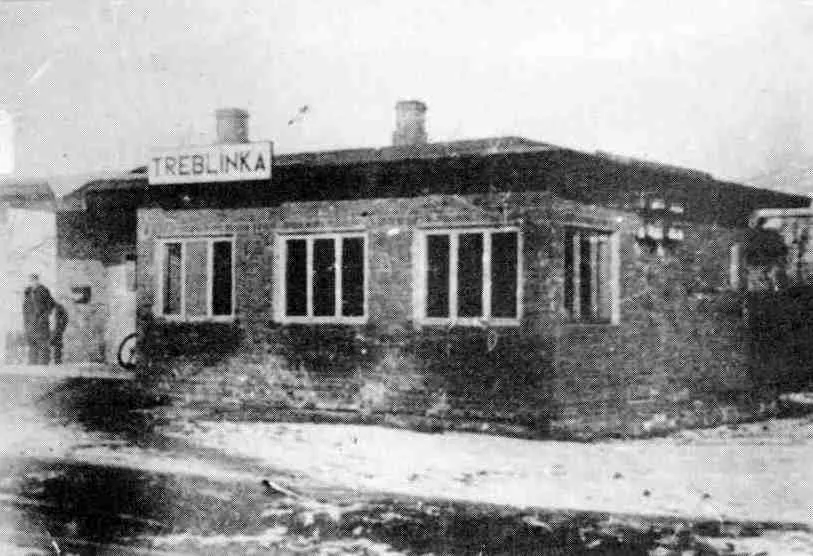
A wooden hut in Treblinka
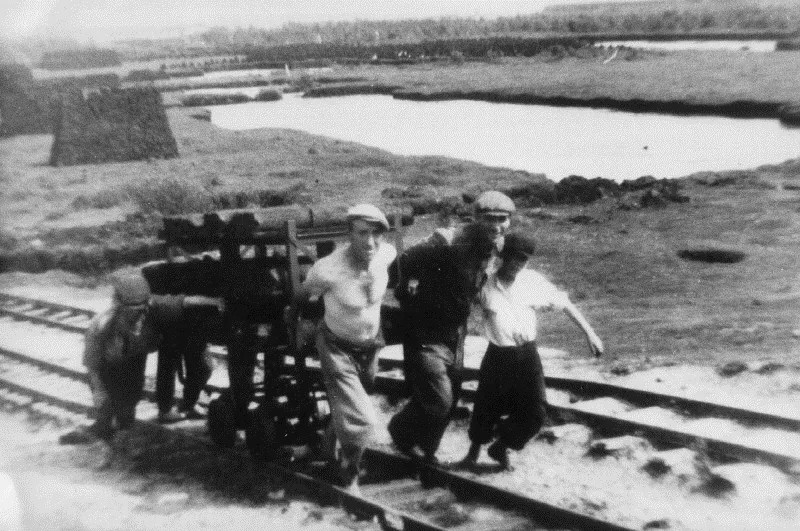
Forced labourers in Treblinka
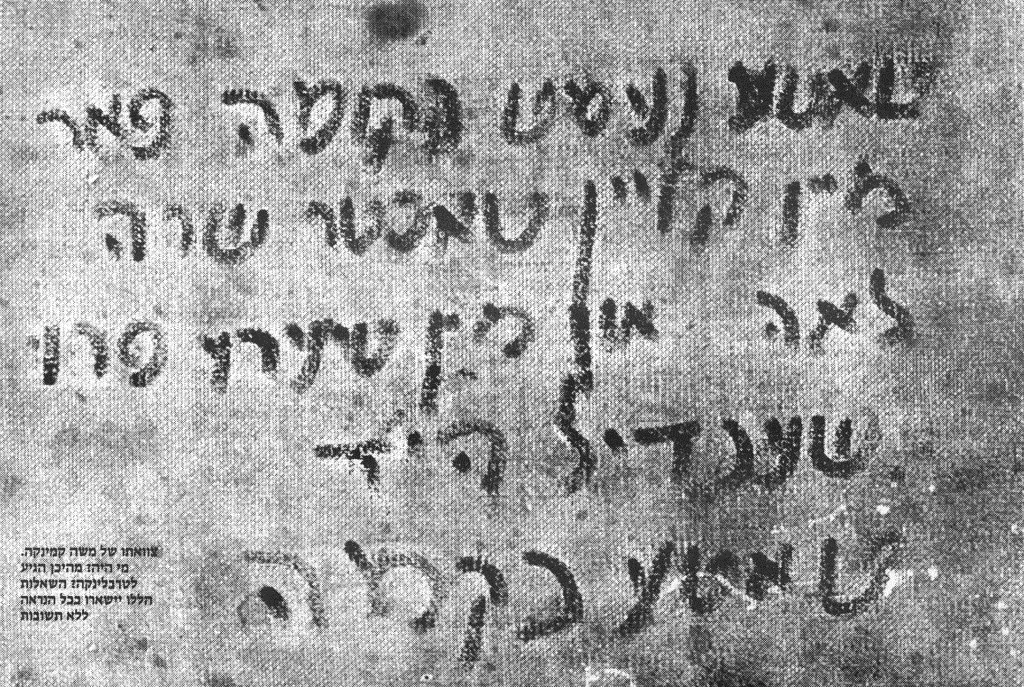
Written on a siddur (prayerbook) that was found on a small farm next to Treblinka: My Father Who is in Heaven, avenge the blood of my young daughter, Sara Leah, and of my wife, Shaindel, Moshe Kaminka, Treblinka
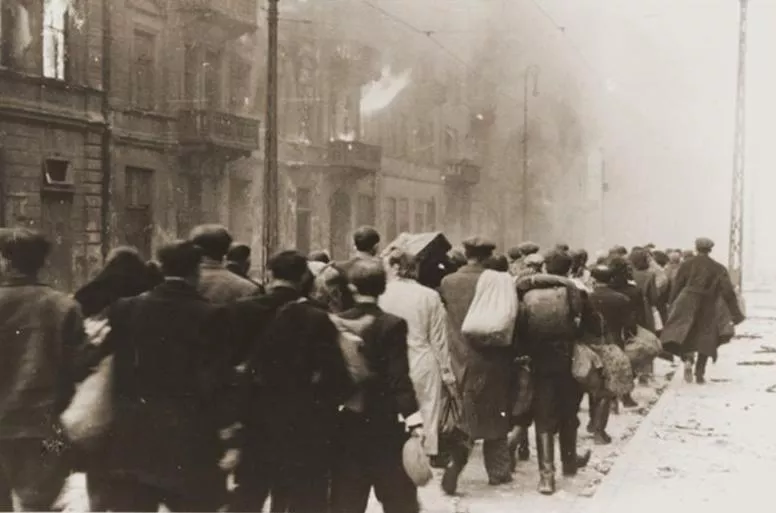
Warsaw Ghetto deportees being led from the burning ghetto to death in Treblinka












